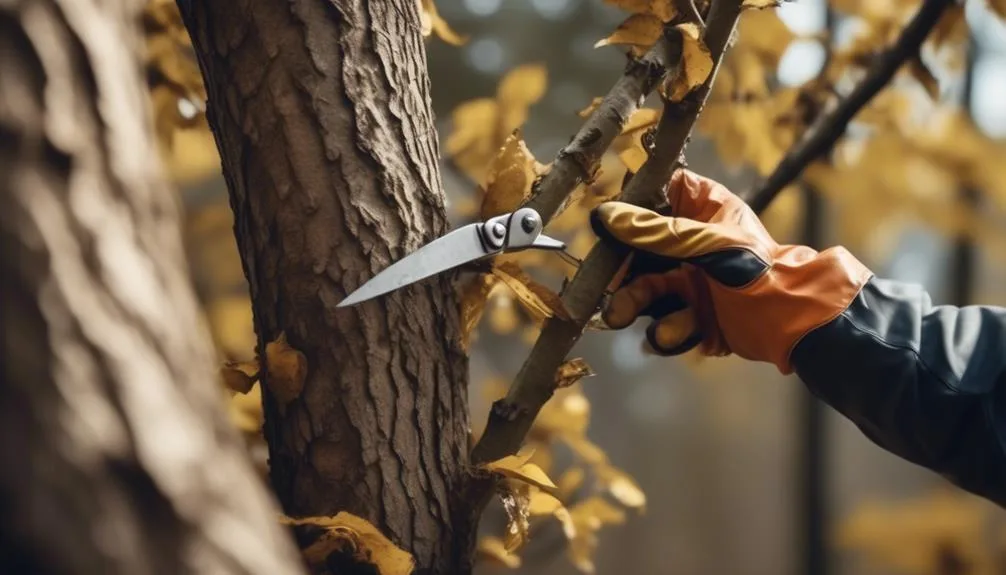Do you have a hickory tree that's getting a bit wild? Learning how to prune it is essential for keeping it healthy and looking good. With different techniques and things to think about, it can be confusing.
In this discussion, we'll talk about the best ways to prune hickory trees, including when to do it, what tools to use, and how to shape and care for them afterward. Stick around to learn how to keep your hickory tree in great shape.
Timing of Pruning
To ensure the health and vitality of your hickory trees, it's crucial to understand the optimal timing for pruning. Seasonal considerations play a vital role in determining the best time to prune your hickory trees.
Ideally, pruning during late winter or early spring, while the tree is still dormant, is recommended. This timing allows the tree to heal quickly and minimizes stress on the tree. Understanding the growth patterns of hickory trees is also essential when deciding when to prune. Pruning during the dormant season encourages new growth in the spring.
Additionally, it's important to consider the overall health and branch structure of the tree before pruning. By assessing the tree's health and growth patterns, you can ensure that your hickory trees receive the best care possible.
Proper Tools and Equipment
Selecting the right tools and equipment is essential for effectively pruning your hickory trees. Ensuring your safety and the health of the tree is crucial, so it's important to use the proper gear and maintain your equipment regularly. Here are some key tools and equipment, along with safety precautions and maintenance tips:
| Tools and Equipment | Safety Precautions & Maintenance |
|---|---|
| Sharp pruning shears | Wear gloves and protective eyewear. Clean and sharpen blades after each use. |
| Loppers | Check for loose parts before use. Oil the pivot and blades regularly. |
| Pruning saw | Use a scabbard for carrying and storage. Clean and oil the blade to prevent rust. |
| Safety harness | Inspect for any wear and tear before each use. Store in a dry, cool place. |
Identifying and Removing Diseased Branches
When identifying and removing diseased branches from your hickory trees, carefully inspect the foliage and branches for any signs of disease, such as discoloration, lesions, or abnormal growths.
To effectively identify and remove diseased branches, follow these steps:
- Start by examining the leaves and branches for any unusual spots, holes, or wilting. Pay close attention to any discoloration or abnormal growth on the foliage.
- Look for any areas of the bark that appear sunken, cracked, or discolored. These may indicate the presence of a disease or pest infestation.
- Check for any signs of fungal growth, such as mushrooms or conks, which could indicate decay within the branches.
Shaping and Thinning Techniques
Consider carefully shaping and thinning your hickory tree to maintain its health and promote strong, well-structured growth. When shaping your hickory tree, focus on maintaining a central leader to encourage upward growth and a well-balanced canopy.
Remove competing or crossing branches to allow for better air circulation and sunlight penetration. Utilize thinning methods to strategically remove excess branches, particularly those that are weak, damaged, or growing at narrow angles. This allows the tree to allocate its resources more effectively, promoting healthier and stronger growth.
When thinning, aim to maintain the tree's natural shape while reducing density to prevent overcrowding. By implementing these shaping and thinning techniques, you can help your hickory tree develop a sturdy structure and thrive for years to come.
Aftercare and Maintenance
To maintain the health and vigor of your hickory tree, it's crucial to provide proper aftercare and regular maintenance. Here are some essential aftercare and maintenance tips:
- Fertilization Schedule and Watering Needs: Develop a fertilization schedule based on the specific needs of your hickory tree. Apply a balanced fertilizer in early spring and late fall. Ensure the tree receives adequate water, especially during dry periods, to promote healthy growth and development.
- Pest Control and Soil Health: Monitor your hickory tree for signs of pests and diseases, and take appropriate measures for control. Additionally, maintain good soil health by regularly testing and adjusting soil pH levels, ensuring proper drainage, and adding organic matter to enhance soil structure and fertility.
Conclusion
By implementing these proven pruning techniques, you can safeguard the well-being and vitality of your hickory trees for years to come.
Remember, proper timing, diligent care, and strategic pruning are the pillars of tree maintenance.
Your attentive efforts today will yield flourishing hickory trees tomorrow.
Mark Hoffman is a dedicated arborist and tree care specialist with over a decade of experience. His love for trees began when he visited Yosemite National Park as a teenager and was awestruck by the giant sequoias. Mark pursued his passion by studying forestry at Michigan Technological University, where he earned a Bachelor of Science degree.
Since then, he has worked tirelessly in the field of arboriculture, helping to preserve and protect trees in his community. His expertise and dedication have made him a respected leader in the industry and a valuable resource for anyone seeking advice on tree care.
